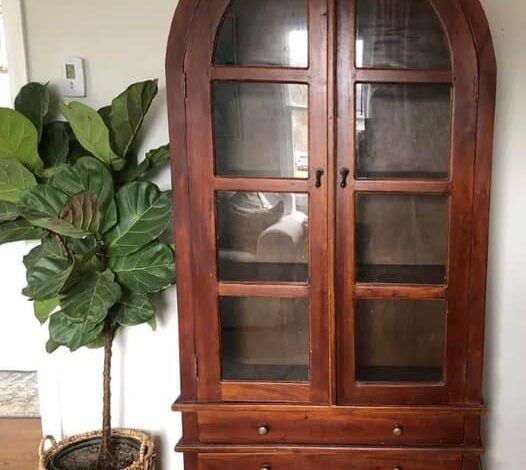How I managed to restore our Arch Hutch with these simple ingredients at home

If you’re someone who appreciates the charm of vintage furniture, particularly unique pieces like arch cabinets, then you’re in for a treat. The allure of these furnishings, with their elegant legs and charming drawers, is undeniable. However, there are times when a piece’s original charm is overshadowed by elements that don’t quite align with your personal style or the ambiance of your home. In this article, we’ll delve into the process of refinishing an arch hutch, transforming it from a dark-stained relic to a stunning centerpiece that truly resonates with your aesthetic.

Unveiling the Beauty Within
The journey of refinishing an arch hutch begins with curiosity and a desire for transformation. As an enthusiast for vintage treasures, you might find yourself drawn to the challenge of uncovering the hidden potential beneath layers of stain. The first step is to evaluate the existing condition and envision the possibilities.


Stripping Away the Past
One method often employed in the restoration process is using a product like citristrip. This powerful solution is designed to remove paint and stain, revealing the natural beauty of the wood underneath. However, as you embark on the restoration of your arch hutch, you might encounter instances where citristrip doesn’t achieve the desired results.


Embracing the Sander
When faced with stubborn stains, the trusty mouse sander becomes an invaluable tool. Through careful sanding, you gradually expose the raw wood, breathing new life into your cherished piece. The sanding process, akin to an artistic endeavor, involves different grits of sandpaper. Starting with 120 grit paper, you meticulously refine the surface, gradually progressing to lower grits for comprehensive restoration.

Navigating the Details
One of the challenges in refinishing intricate furniture pieces lies in addressing detailed areas. These nooks and crannies can be elusive to standard sanding methods. However, with determination and the right tools, you can conquer this task. Employing the strength of a bristle brush and the efficacy of afterwash, you deftly navigate these complexities, revealing the hidden allure within the details.

The Lightening Touch
As the stain is lifted and the wood’s natural charm emerges, a decision must be made regarding the wood’s undertone. While the raw color is a sight to behold, certain undertones might not align with your vision. The process of lightening the wood involves finesse and precision.
Bleach to the Rescue
To achieve the desired color palette, the introduction of household bleach becomes a transformative step. Applying layers of bleach to specific sections of the piece allows you to control the degree of lightening. Each coat of bleach contributes to the gradual evolution of the wood’s hue, ensuring a harmonious blend with your intended aesthetic.

The Finishing Flourish
With the wood’s transformation nearing completion, attention turns to the finishing touches. The interior of the arch hutch offers an opportunity for personalization, whether through a fresh coat of paint or the addition of decorative elements.

Captivating with Beadboard
For the back of the hutch, beadboard presents an elegant solution. The introduction of this textured paneling not only enhances visual appeal but also adds depth and character to the piece. The process of applying beadboard requires precision and patience, resulting in a backdrop that complements the arch cabinet’s overall design.

A Flawless Finish
The final stages of the restoration process involve ensuring a flawless exterior and interior. Applying a high-quality primer, such as BIN Zinsser, prepares the surface for the finishing paint. A carefully chosen shade of white envelops the arch hutch, highlighting the intricate details and paying homage to its vintage origins.

The journey of refinishing an arch hutch is a testament to the transformative power of restoration. By peeling away layers of time and stain, you breathe new life into a piece that holds historical and aesthetic significance. The delicate dance of sanding, lightening, and painting culminates in a creation that seamlessly bridges the past and the present, gracing your living space with elegance and allure.

Frequently Asked Questions
What is the role of citristrip in the restoration process?
Citristrip plays a vital role in removing paint and stain from vintage furniture, helping reveal the natural wood beneath the surface.
How does afterwash aid in stain removal?
Afterwash is a potent chemical that effectively removes stubborn stains. When applied with care and precision, it can rejuvenate intricate details without damaging the wood.
How does bleaching contribute to the lightening process?
Bleaching introduces controlled lightening to the wood’s undertone, ensuring a harmonious color palette that aligns with your aesthetic vision.
What is the significance of beadboard in the restoration?
Beadboard enhances both the visual appeal and depth of the piece, adding a touch of texture and character to the arch hutch’s design.
How does the arch hutch restoration process honor its vintage origins?
The restoration process pays homage to the piece’s vintage origins by preserving its intricate details while updating its appearance to seamlessly fit contemporary settings.




